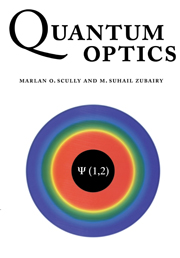Book contents
- Frontmatter
- Contents
- Dedication
- Preface
- 1 Quantum theory of radiation
- 2 Coherent and squeezed states of the radiation field
- 3 Quantum distribution theory and partially coherent radiation
- 4 Field–field and photon–photon interferometry
- 5 Atom–field interaction – semiclassical theory
- 6 Atom–field interaction – quantum theory
- 7 Lasing without inversion and other effects of atomic coherence and interference
- 8 Quantum theory of damping – density operator and wave function approach
- 9 Quantum theory of damping – Heisenberg–Langevin approach
- 10 Resonance fluorescence
- 11 Quantum theory of the laser – density operator approach
- 12 Quantum theory of the laser – Heisenberg–Langevin approach
- 13 Theory of the micromaser
- 14 Correlated emission laser: concept, theory, and analysis
- 15 Phase sensitivity in quantum optical systems: applications
- 16 Squeezing via nonlinear optical processes
- 17 Atom optics
- 18 The EPR paradox, hidden variables, and Bell's theorem
- 19 Quantum nondemolition measurements
- 20 Quantum optical tests of complementarity
- 21 Two-photon interferometry, the quantum measurement problem, and more
- Index
10 - Resonance fluorescence
Published online by Cambridge University Press: 05 June 2012
- Frontmatter
- Contents
- Dedication
- Preface
- 1 Quantum theory of radiation
- 2 Coherent and squeezed states of the radiation field
- 3 Quantum distribution theory and partially coherent radiation
- 4 Field–field and photon–photon interferometry
- 5 Atom–field interaction – semiclassical theory
- 6 Atom–field interaction – quantum theory
- 7 Lasing without inversion and other effects of atomic coherence and interference
- 8 Quantum theory of damping – density operator and wave function approach
- 9 Quantum theory of damping – Heisenberg–Langevin approach
- 10 Resonance fluorescence
- 11 Quantum theory of the laser – density operator approach
- 12 Quantum theory of the laser – Heisenberg–Langevin approach
- 13 Theory of the micromaser
- 14 Correlated emission laser: concept, theory, and analysis
- 15 Phase sensitivity in quantum optical systems: applications
- 16 Squeezing via nonlinear optical processes
- 17 Atom optics
- 18 The EPR paradox, hidden variables, and Bell's theorem
- 19 Quantum nondemolition measurements
- 20 Quantum optical tests of complementarity
- 21 Two-photon interferometry, the quantum measurement problem, and more
- Index
Summary
The phenomenon of resonance fluorescence provides an interesting manifestation of the quantum theory of light and is a “real world” application of the material of the Chapters 8 and 9. In this process, a two-level atom is typically driven by a resonant continuous-wave laser field and the spectral and quantum statistical properties of the fluorescent light emitted by the atom are measured. Experimentally this can be achieved by scattering a laser off a collimated atomic beam such that the directions of the laser beam, atomic beam, and detector axis are mutually perpendicular as shown in Fig. 10.1.
If the driving field is monochromatic, then at low excitation intensity the atom absorbs a photon at the excitation frequency and reemits it at the same frequency as a consequence of conservation of energy. The spectral width of the fluorescent light is therefore very narrow. The situation, however, is considerably more complicated when the excitation intensity increases and the Rabi frequency associated with the driving field becomes comparable to, or larger than, the atomic linewidth. At such intensity levels, the Rabi oscillations show up as a modulation of the quantum dipole moment and sidebands start emerging in the spectrum of the emitted radiation. This so-called dynamic Stark splitting is an interesting feature of the atom–field interaction. In addition to that, the fluorescent light exhibits certain nonclassical properties including photon antibunching and squeezing.
In this chapter, we develop a theory of resonance fluorescence to explain these phenomena.
Information
- Type
- Chapter
- Information
- Quantum Optics , pp. 291 - 326Publisher: Cambridge University PressPrint publication year: 1997
